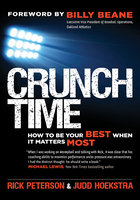
The Steps to Reframing
For those readers who value a process-oriented approach, here is a quick look at the steps I used to reframe my thinking about Cole’s hockey tryout.
1. Pause and Recognize Your Caveman’s Story. Pay attention to your reflexive self-talk—the story your Caveman is telling you. Ask yourself, “Do I want to think, feel, or act this way?”
Remember, you cannot stop the reflexive reaction to a pressure situation by the Caveman. However, you can stop the Caveman from acting on this reflexive reaction. It’s important to recognize our Caveman presents its reflexive thinking as a command. In reality, it is not a command. It is merely an offer to your Conscious Thinker to act in a certain way. The choice about how you will think and act belongs to your Conscious Thinker.
2. Challenge Your Caveman’s Story. Question the most seemingly unassailable beliefs and assumptions. Remember, your brain is like a computer. It doesn’t know the difference between the truth and a lie. It just responds to what you fill it with. If your Hard Drive is filled with bad beliefs and assumptions (note: we all have them), it will produce a bad result. Garbage in, garbage out.
When Garry Ridge, Hall of Fame reframer and WD-40 Company CEO, faces a pressure situation, he pauses and asks himself why he thinks and feels the way he does. More specifically, he asks himself:
More specifically, he asks himself:
 What assumptions am I making in this situation?
What assumptions am I making in this situation?
 What’s driving these assumptions—fact, fiction, or opinion?
What’s driving these assumptions—fact, fiction, or opinion?
 What am I afraid of?
What am I afraid of?
We’ll learn more about reframing from Garry in Chapter 7, including the fabulous results achieved by WD-40 Company.
Don’t let the force of an impression when it first hit[s] you knock you off your feet; just say to it: Hold on a moment; let me see who you are and what you represent. Let me put you to the test.
—Epictetus
3. Explore Different, Rational Stories. Identify at least two different ways of viewing the current situation. Ask yourself questions to open up your mind to possibilities:
 How else can I think about this?
How else can I think about this?
 Where can I find humor in this?
Where can I find humor in this?
 How might <insert name of person you admire and respect> think about this?
How might <insert name of person you admire and respect> think about this?
 What would I tell my kids to do in this situation?
What would I tell my kids to do in this situation?
 What would I do if I weren’t afraid? Note: Facebook stamps this question on bold colored posters throughout its facilities, reminding employees daily to move from threat to opportunity.
What would I do if I weren’t afraid? Note: Facebook stamps this question on bold colored posters throughout its facilities, reminding employees daily to move from threat to opportunity.
If you are stuck and can’t come up with alternatives on your own, ask those around you to share how they view the situation.
4. Choose and Act on Your Best New Story. Choose the story that most increases your sense of control, confidence, and vision of success. Remember, fill your Hard Drive with thoughts and beliefs that come from you, the Conscious Thinker.
By overriding the reflexive thoughts that aren’t helping us with new thoughts that do help us, we can move from experiencing pressure as a threat to perceiving it as an opportunity. The more we flex this new muscle, the more it becomes habit. In fact, research shows we can actually rewire the neural pathways in our brain, overriding old habits and developing new habits. This is referred to as neuroplasticity. It’s a fancy way of saying…
You can teach an old brain new tricks.
Throughout the course of this book, our stories will highlight various aspects of the reframing pressure process. With that said, it’s our belief the stories we share will be your best teacher. Why? Quite simply, for most of us, processes aren’t as memorable as stories.

FIGURE 2.1: Two responses to pressure—act on your threat reflex or choose to reframe as an opportunity
Take the high road as often as possible. It rarely has bumper to bumper traffic.
—Author Unknown